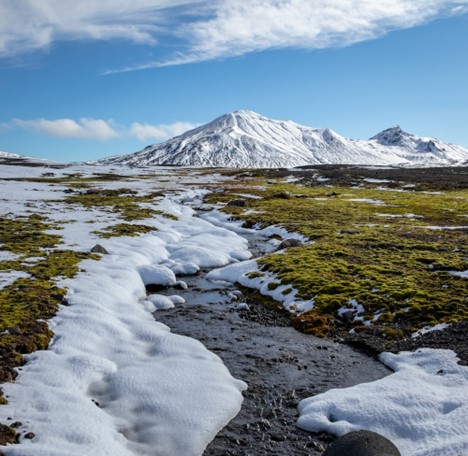
Tundra is a Sami word that comes from the Sami-speaking people who traditionally lived in the Saapmi region, which today encompasses the large northern areas of Norway, Sweden, Finland and Russia’s Kola Peninsula.
Meaning “barren land”, refers to a treeless arctic region characterized by permafrost.
[Permafrost: Any ground that remains completely frozen—32°F (0°C) or below—for at least two years. These permafrost are located in high mountain regions and at high latitudes of the Earth – near the North and South Poles.]
The tundra region of northern Arctic Canada is known for its freezing temperatures, treeless, low-growing shrubs, and abundant rock. The southern limit of the tundra in Canada extends from the delta of the Mackenzie River to southern Hudson Bay and northeast to the Labrador Peninsula. The term “alpine tundra” is often used to describe any area above the tree line in mountainous areas. “Alpine tundra” and “Arctic tundra” refer to different regions. (Although the two regions have some similarities, the differences are significant.)
[ Worldwide, there are two types of tundra – alpine and arctic. Alpine tundra is usually found high up in mountains where temperatures are cold, with long winters. Arctic tundra is a treeless arctic region where the climate is cold, windy, and without precipitation. The tundra lands are covered in snow most of the year, but in the summer wildflowers bloom and arctic animals live.]
Tundra environments are mainly dominated by permafrost. But except for lake and river beds. This surface or frozen ground is under several meters of ice. Summers in this tundra region are short but have almost continuous daylight. Again there is a long sunless winter (called the “Polar Night”). The region is also nicknamed the Polar Desert. High winds and snow storms are special features in winter.
Tundra regions are found in many places around the world. For example, Canada, the United States, Greenland, Norway and Russia extend across Antarctica and the North Pole. Tundra ecosystems are also found in southern Chile, Kings Canyon in California, and the higher reaches of the Himalayas.
Flora and Fauna:
Even in these cool temperatures of the tundra, many small shrubs grow and animals live – two percent of the global flora and fauna. Although this number may seem small for such a large part of the planet, species diversity among some tundra plants is greater than in warm and temperate ecosystems. Bacteria and fungi are also important components of tundra ecosystems.
Tundra plants such as lichens (fungi living closely with green algae), mosses, specialized grasses, and less shrubs are often perennial and have short reproductive cycles. Wind disperses their seeds rather effectively. Although some species are capable of asexual reproduction.
Tundra plants adopt many ways to survive. Their low height exploits a favorable microclimate close to the ground, as the small thick and tough leaves help trap moisture.
[Microclimate is the measurement of climate in local areas near the Earth’s surface. These environmental variables—including temperature, light, wind speed, and humidity—provide meaningful indicators for habitat selection and other ecological activities.]
Many mammals, birds and fish live in the tundra region in the summer, but migrate elsewhere in search of food each fall. Not all, however, leave the territory in winter, as foxes, hares, polar bears, seals and birds such as the long-tailed jaeger remain.
Rock ptarmigan birds:
The rock ptarmigan is a medium-sized game bird of the grouse family. It can also be seen in the UK simply known as Petermigan. It is the official bird of the Canadian territory tundra region of Nunavut, where it is known as the Akigik, and also the official game bird of the province of Newfoundland and Labrador.
Along with 3,300 different types of arctic insects, more than 75 mammals, 240 bird species, 5 amphibians and 2 reptiles live in the tundra.
Human Activities:
Humans have lived in the tundra of North America for about 14,000 years. Early hunter-gatherers crossed the Bering Land Bridge to present-day Alaska (Beringia). Using sophisticated rock-carving tools, they hunted large mammals and expanded their populations, spreading throughout the Arctic and the rest of the continent.
Today, Canada’s arctic tundra is home to more than 100,000 people, most of whom identify as First Nations, Inuit and Métis. From resource extraction to new economic development, population growth and climate change, the region is undergoing rapid transformation.
Global Temperature:
Since 1880, Earth’s average surface temperature has risen by about 0.7 degrees Celsius.
According to statistics from the NASA Goddard Institute for Space Research. (Courtesy of NASA Earth Observatory, Mike Karlowitz.)
Rising sea levels and a warming atmosphere threaten to reduce the size of Canada’s tundra. Rising temperatures are causing numerous plant and animal species to migrate north and to higher elevations in search of cooler climates. Such a scenario is putting pressure on the inhabitants of the tundra to adapt to the unfamiliar conditions in the landscape once again.
